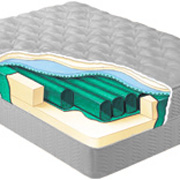Temperature control
Floating-like feel
Will not lose support
Contouring to body
Pressure relief
Relatively inexpensive
Waterbed
Waterbed Mattresses
 It has been a long time since waterbeds were on the pedestal of the mattress industry. Once the luxury product popular in 70’s and 80’s lost much of its luster and is quite hard to find in the showroom. It still has its share of devoted follower but they have to stick to online stores for the replacements or spare parts.
It has been a long time since waterbeds were on the pedestal of the mattress industry. Once the luxury product popular in 70’s and 80’s lost much of its luster and is quite hard to find in the showroom. It still has its share of devoted follower but they have to stick to online stores for the replacements or spare parts.
The main feature of waterbeds is the use of liquid for support, just like air is used in air/dial mattresses. With advances in technology, along with other mattress types, even waterbeds went through many changes and improvements over time. New models look quite similar like innerspring mattresses with comfort layers and ticking on top.
There are two types of waterbeds currently available – hard-sided and soft-sided. Hard-sided waterbeds use traditional design where a bladder (water filled chamber) is sitting inside of the wooden frame. Soft-sided waterbeds, sometimes referred to as hybrids, use high density foam walls instead of wood frame to support the bladder in place. They closely resemble traditional innerspring mattress with several layers of padding and upholstery.
Most of the waterbeds offer an option to control their temperature. For many people this is the most important feature of this mattress type and is provided by special electric pad sitting under the water bladder. Heating is essential for hard-sided waterbeds where there is not enough insulation between the body and water.
With latest improvements in construction and durability of waterbeds there is very low risk of puncturing or bladder leakage. Bladders are made from heavy-duty vinyl and in most cases are enclosed with a safety, waterproof liner for additional protection.
Most of the past problems have been eliminated but there are still concerns with initial odor, possible noise, weight and maneuverability, and necessary assembly and maintenance.
Hard-sided waterbeds use traditional design where a bladder (water filled chamber) is placed inside of the wooden frame, which sits on the top of specially designed platform with wooded deck to evenly spread the weight. The wooden frame can be decorative and can blend in with other furniture. Hard-sided waterbeds are more difficult to get in or out of. These waterbeds generally use less padding on the top of the bladder and some models use none to provide unique, floating feel. In any case, ability to control the temperature with this design becomes crucial.
The basic construction of soft-sided waterbed is identical and it has the same features. The main difference is the foam walls that surround the bladder instead of wooden boards. High-density foam encasement provides enough support and durability and makes it easier to move in and out of the mattress. Soft-sided waterbed design uses similar construction of the upper, comfort layers that provide cushioning and additional pressure relief. The top cover of the soft-sided waterbed may be removable, which is a great feature providing hygienic sleeping surface.
The construction of waterbeds improved to eliminate the risk of puncturing or bladder leakage. Bladders are made from heavy-duty vinyl and in most cases are enclosed with a safety, waterproof liner for additional protection. The vinyl should be at least 20 millimeters thick, although there are some models with up to 30 mm thickness.
To control the temperature of the sleeping surface, waterbeds either use a built-in electric heating pad placed directly under the bladder, or use a thermal layer to protect and insulate the body.
Waterbed bladders come in different levels of depth, sometimes referred to as fill levels. They come in 3-5 inches (shallow), 5- 6 inches (mid-fill) or 7- 8 inches (deep fill). Shallow fill bladders are usually used only in soft-sided waterbeds, with padding layers of foam on the top providing additional comfort.
Free flow waterbeds use original design with the one big bladder that creates waves with even a slight movement on the surface. The floating feeling was cherished by some but detested by others that complained about lack of support and continuous, disturbing motion.
To improve the motion transfer and increase firmness, manufacturers began implementing fiber filling – placing motion dampening fiber materials into the bladder. By adding larger amount of fiber filling, manufacturers improve motion separation and increase firmness, offering semi-waveless, waveless and ultra motionless mattresses.
Another way to improve motion separation and support in waterbeds is to separating the main bladder into smaller compartments. Just like with air chambers in air/dial beds, waterbeds used the same design with two separate chambers or dual bladders, allowing different firmness and temperature on each side.
Another innovative design uses bladder that is further divided into many small compartments. It allows water to flow slowly and gradually through tiny holes between compartments, thus providing firmer support and improved motion separation.
Yet another design features independent vertical tubes that can be easily filled and drained. Tubes can be filled up to different level on each side of the bed providing desired firmness level. Vertically lined up tubes offer reduction in motion.
There is no need to regularly drain the water out of the waterbed. Special waterbed conditioner known as an algaecide needs to be added to the bladder every six months to prevent the development of bacteria or algae. You may have to top off the water inside the mattress once a year.
The only time you have to fully change out the water in the bladder is when you move. A full-sized bladder takes anywhere from 1 to 6 hours to drain. If your waterbed develops a leak, you will have to patch it with a waterbed repair kit, which is a fairly simple process and can take around 30 minutes.
Since you will have hard time to find a waterbed in the mattress store showroom, you will spend most of your time doing your research and shopping online. There are several well-established waterbed manufacturers and a few newcomers to this category so compare specifications deliberately and read plenty of customer reviews.
Waterbed warranties vary quite a bid depending on the type of bladder, material used and manufacturer. Most of waterbed warranties start with the short non-prorated period (2-5 years) followed by longer prorated period, with overall warranty duration between 7 to 20 years.
Make sure you ask your store about exchange/return options and exchange/return costs. Read the fine print of the exchange/return policy before you place an order. Some retailers charge delivery and old mattress removal fees that can significantly add to the final amount.
